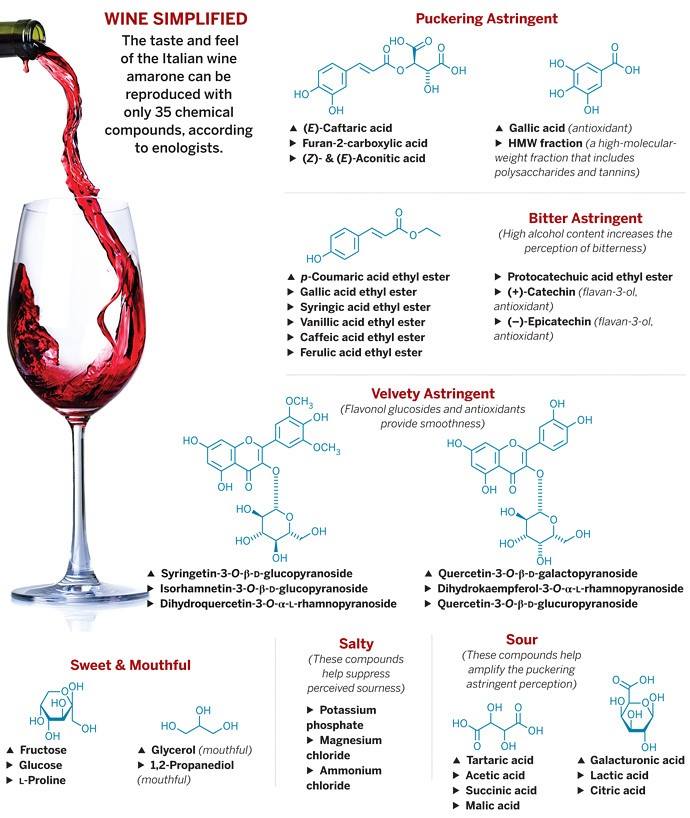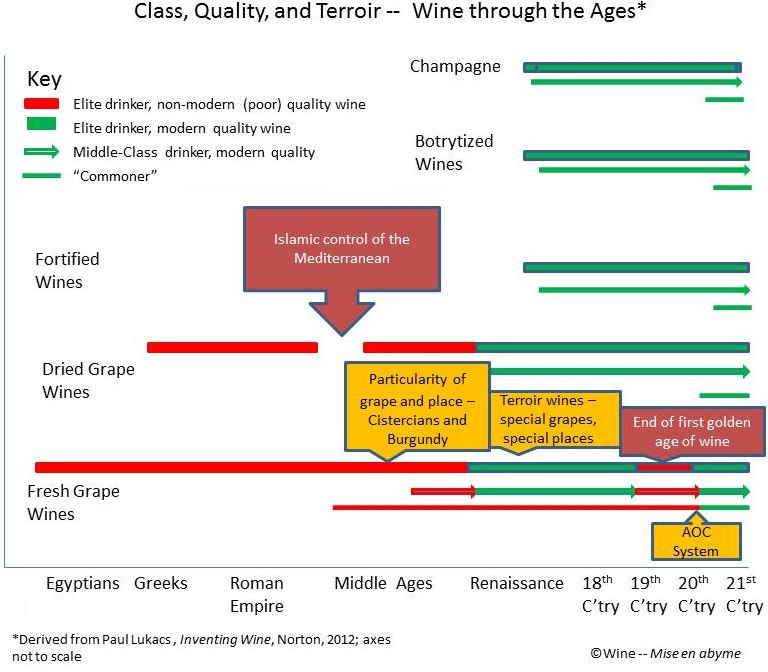관능(Wine 풍미) 영향요소
식품의 역할 ≫ 기호성 ≫ 관능검사
관능(Wine 풍미) 영향요소
와인 풍미요인
- 포도 , 포도의 차이
- 향기 성분
- 맛성분
- 색과 식욕
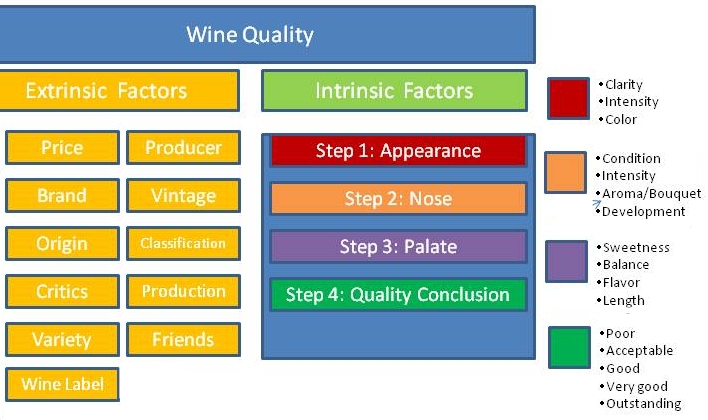
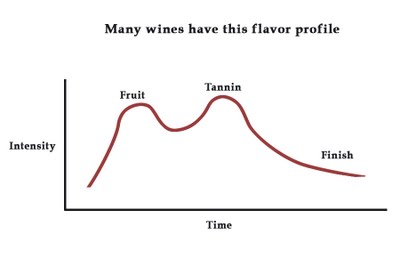
1. Factors Influencing Taste and Mouthfeel.
The following is a review of some of the major features regarding taste and mouthfeel. As we all know, if as a group we were to evaluate a wine, it is not likely we would have the same response to the product’s attributes and deficiencies. Beyond that, without standardization, it is very difficult for individuals to provide a consistent response.
2 In proper wine sensory evaluation, we must keep the following confounding features in mind and minimize their effects.
Problems with non-standardized sensory responses:
• Adaptation
• Cross adaption
• Individual variability
• Difficulty in separating some sensory components
• Non-standardized language
• Expectations/bias
Our goal is to improve wine quality by enhancing our ability to understand the limits and potential of sensory evaluations.
Proper sensory evaluation at the winery involves the following:
• Standardized and controlled environment
• Representative sample
• Proper sample temperature
• Established common language
• Understanding the importance of sample contrasts
• Proper number of evaluators required to gain a true picture
• Using the proper testing method
Variation in sensory response can be the result of the following variations, which are outlined below:
• Genetic
• Biological
• Physiochemical
• Psychological
c. Physicochemical Variation. We know that wine balance can be viewed as the reciprocal-type relationship indicated below. An increase in the perception of components on the left side decreases the perception of components on the right.
Sweet/Body ↔ Acid + Phenols (tannin intensity, astringency, dry tannins and bitterness)
Palate balance is impacted by a number of features, including temperature:
• Cooling reduces sweetness of sugars
• Cooling reduces bitterness of alkaloids
• Cooling increases the sense of acidity
• Cooling increases bitterness and astringency of tannins
Wineries generally serve all their whites at one temperature, and all their reds at another. Based on the palate balance relationship, this may not be optimal.
Sugars. Sugar concentrations above 0.2% are generally required to exhibit perceptible sweetness. When sweetness is detected in dry wines, it is usually due to the presence of a noticeable fruity fragrance. Association between fruity odors and sweetness has trained us to instinctively affiliate the presence of fruity odors with sweetness, even in its absence (Prescott, 2004).
Sugars begin to have a pronounced influence on sweetness and affect the perception of body at concentrations at or above 0.5%. The influence of aromatics on the perception of the sweetness of sugar can be very important. Thus, the fragrance of a wine may not only evoke the perception of sweetness, but also increase the perceived intensity of sweetness. We discussed this in relationship to rosé wine production.
Body. Despite the importance of body to the overall quality of wines, its precise origin remains unclear. Gawel et al. (2007) found a correlation between higher ratings for flavor and/or perceived viscosity with body. In sweet wines, body is often viewed as being roughly correlated with sugar content. In dry wines, it has often been associated with alcohol content.
There is evidence that the macromolecular content of wines (yeast proteins and polysaccharides) may play a role in the overall perception of body (Vidal et al., 2004a, b). Features such as a wine's fragrance can influence the perception of body and, conversely, increasing the sugar content can increase the perception of fragrance.
Polysaccharides. Polysaccharides, either grape- or yeast-derived, play a role in reducing acidity and astringency. They add to the perception of sweetness/body and
thus lower the perception on the other side of the palate balance relationship. This
influence can be significant, and is the basis for the interest in yeast fining and some
commercial addition products.
Alcohol. Ethanol possesses a sweet aspect. The acidity of wine diminishes as the
alcohol increases. Ethanol slightly enhances the sweetness of sugars, while reducing
the perception of acidity. At high concentrations (above 14%), alcohol increasingly
generates a burning sensation and may contribute to the feeling of weight or body,
especially in dry wines.
Acids. The effect of acidity in diminishing perceived sweetness appears less than that
of sugar in suppressing the perception of acidity (Ross and Weller, 2008). Of the
common acids found in wine, malic acid is the most sour tasting, whereas lactic acid is
generally considered the least sour.
The perceived intensity of a mixture generally reflects the intensity of the dominant
component, not a summation of their individual effects (McBride and Finlay, 1990).
pH also impacts taste perception, both directly by influencing the ionization of salts and
acids, and indirectly affecting the shape and biological activity of proteins. Structural
modification of receptor proteins on gustatory neurons could significantly affect taste
responsiveness.
The use of oral hygiene products, which can impact taste buds, make most wines taste
much more of acidity. The so-called Orange Juice Effect is the result of sodium lauryl
sulfate (or sodium dodecyl sulfate, two names for a common toothpaste ingredient) that
can react with taste buds (DeSimone et al., 1980). This is a primary reason why sensory
evaluations are generally not conducted too early in the morning.
Saltiness. The salt of some cheeses can suppress the bitterness of red wines. These
influences may or may not affect response time, duration, and maximum perceived
intensity.
Taste- and mouthfeel-components can affect taste:
• Ethanol enhances the perception of sugar-induced sweetness.
• Ethanol suppresses the astringency of tannins.
• Ethanol enhances flavonoid-induced bitterness (Noble, 1994) when the alcohol level is relatively high.
• Acids increase the perception of bitterness and astringency.
Mouthfeel. Mouthfeel is a generalized term used to describe the multiple sensations of
the following:
• astringency
• touch
• viscosity/body
• burning
• temperature
• prickling from carbon dioxide
• pain
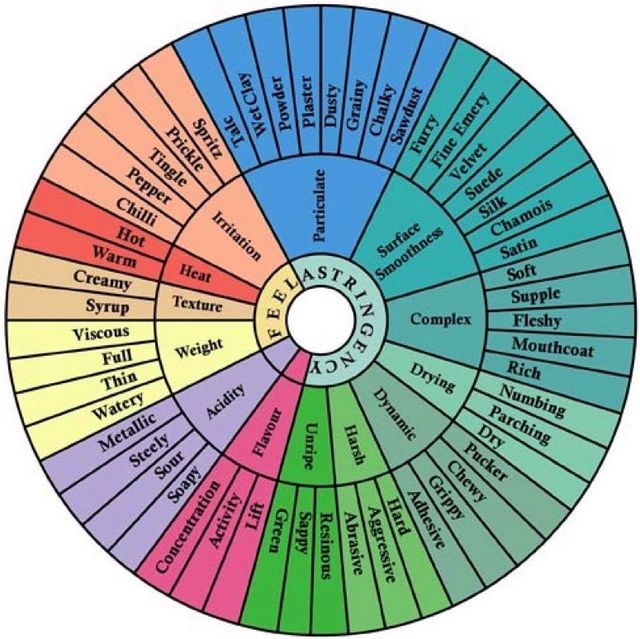
The combination of these sensations with those from the nose produces the perception of flavor. Unlike gustatory and olfactory sensations, mouthfeel activation occurs slowly, and adaptation is also slow or may not develop. Adaptation is particularly evident in the increased intensity of astringent sensations on repeated exposure to red wines, consequently, the use of palate cleansers is recommended during tasting.
Astringency and Bitterness.
Astringency is primarily induced by flavonoid tannins that come from grape seeds and skins. Anthocyanins can enhance the perceived
astringency of tannins, but do not contribute to wine bitterness (Brossaud et al., 2001).
Astringency is commonly confused with bitterness. Both perceptions develop comparatively slowly and possess lingering aftertastes.
Astringency may partially mask bitterness (Arnold and Noble, 1978), and is more often confused with bitterness than the inverse.
Astringency is thought to result from the binding and precipitation of proline-rich salivary proteins and glycoproteins with phenolic compounds. pH affects protein hydration and ionization of both phenol and protein.
Astringency is one of the slowest in-mouth sensations to develop. Depending on the concentration and types of tannins, astringency can take up to 15 seconds before reaching maximal intensity. The decline in perceived intensity occurs even more slowly.
The intensity and duration of an astringent response often increases with repeat sampling (Guinard et al., 1986). This phenomenon is less likely to occur when the wine is consumed with food, owing to reactions between tannins and proteins in the food, as well as due to dilution.
Mouthfeel time intensity characteristics include the following:
• Activation occurs slowly.
• Adaption occurs slowly, as evidenced by increased intensity upon repeated exposure.
• Astringency intensity and duration often increase with repeated exposure.
• Interaction of salivary proteins can be blocked by incorporation of lees peptides and other sulfur-containing side groups.
Molecular size is one of the more important factors influencing tannin-induced
astringency. Bonding is roughly correlated with molecular size (polymerization). Steric
hindrance (geometry) limits the availability of some binding sites.
Phenol features and relationships include the following:
• Lower pH equates to higher perception of astringency.
• Higher alcohol generally lowers perception of astringency and increases perception of bitterness.
• Increased polymerization augments drying, chalky, grainy, puckery attributes.
• Increased galloylation (flavonoids esterified with gallic acid) augment rough or course attributes, as well as dryness (Vidal et al., 2003); galloylated tannins are common in seed tannins.
• Velvety astringency in reds is positively correlated with flavonol glycosides.
• Positive correlation between color and perceived tannin “quality.”
• Incorporation of anthocyanins terminates tannin polymerization.
• Generally, greater color is correlated with finer tannins.
• Flavanone glycoside and tyrosol produced by yeast contribute to the slight bitterness of white wines.
Phenols can often have more than one sensory response. In mixtures, this can significantly affect overall taste quality. For example, small tannins (small molecular weight polymers) may be both bitter and astringent.
The interaction of taste and mouthfeel components forms the basis of food and wine pairing. For a discussion of food and wine pairing exercises you can conduct at the winery with your clients, see Food and Wine Pairing at www.vtwines.info.
Additionally, for examples of how to determine wine preferences with regard to taste and mouthfeel elements, go to www.yumyuk.com and take the Taste SQ interview.
d. Psychological Variation. We know that color, bottle shape, closure type, etc., creates a certain bias for or against, which can influence our perception of the product.
Bias must be eliminated if a true sensory impression is desired. The development of bias often has cultural origins, expressed in ethnic differences in odor/taste judgments.
2.Volatile Acidity.
The following is adapted from Zoecklein et al. (2005). The total acidity of a wine is the result of the contribution of nonvolatile or fixed acids, such as malic and tartaric, plus those acids separated by steam volatilization, or volatile acids. A measure of volatile acidity is used routinely as an indicator of wine spoilage.
Although generally interpreted as acetic acid content (in g/L), a traditional volatile acidity analysis includes all those steam-distillable acids present in the wine. Thus, significant contributions to volatile acidity (by steam distillation) may be made by carbon dioxide (as carbonic acid), sulfur dioxide (as sulfurous acid) and, to a lesser extent, other organic acids.
a. Microbiological Formation of Acetic Acid. The volatile acidity of a sound, newlyfermented dry table wine may range from 0.2 to 0.4 g/L. Increases beyond this level, however, may signal microbial involvement and potential spoilage. The principal source of acetic acid post-fermentation in stored wines is attributed to growth of acetic acid bacteria and certain lactic acid bacterial species.
b. Formation of VA by Spoilage Yeasts. In some cases, high levels of volatile acidity may result from growth of yeast during fermentation. There is considerable variation in production of acetic acid and other byproducts among both native and cultured wine yeast strains of Saccharomyces spp. Among those yeasts involved in acetification of wine, Brettanomyces is known to produce relatively large amounts. In one study, acetic acid production by Brettanomyces in white wine after 26 days of incubation (28°C/82.5°F) increased from 0.31 g/L to 0.75 g/L.
Acetic acid is a normal by-product of yeast growth and has its origin primarily in the early stages of fermentation. Several intrinsic and extrinsic factors may affect formation of acetic acid by yeast, including the following:
• pH
• Sugar
• Available nitrogen
• Fermentation temperatures
• Interactive effects of other microorganisms
• Botrytis and other fruit fungi
pH impacts acetic acid production, with more acetic acid produced at low (<3.2) pH. The effect of increased osmotic pressure, resulting from high-sugar musts, on volatile acid formation is well known. Such fermentations typically have a longer lag phase with reduced cell viability and vigor. Generation time (budding) is also delayed. At initial fermentable sugar levels above 20%, acetic acid increases with sugar level and has been found to range from 0.6 to 1.0 g/L in musts of 32 to 42°Brix (17.7 to 23.3°Baumé), compared with controls at 22°Brix (12.2°Baumé) with acetic acid of 0.4 g/L. Visually, yeast cells growing under conditions of high osmotic pressure appear stressed.
Must nitrogen levels may also play a role in acetic acid formation. When available
nitrogen is low, higher initial sugar levels (as seen in over-ripe or mold-damaged fruit)
may lead to increased production of acetic acid.
Fermentation temperature is also known to affect the levels of acetic acid produced by
wine yeasts. An early study found that volatile acid formation increased with increased
fermentation temperature, over the range of 15°C (59°F) to 25°C (77°F).
Significant differences between yeast strains have been reported. In one study, it was
noted that the formation of acetic acid was maximal at 40°C (104°F) in one strain of S.
cerevisiae, whereas maximum formation occurred at 10°C (50°F) in a second strain.
Unless controlled, the temperature of fermentation may rise to a point at which it
becomes inhibitory to wine yeast. In practice, inhibition may be noted at temperatures
approaching 35°C (95°F) or higher. Because acetic and lactic acid bacteria can tolerate
temperatures higher than those needed to kill (inhibit) wine yeasts, stuck or protracted
fermentations often are susceptible to secondary growth of these organisms.
Pressure fermentations may also result in higher than expected volatile acid content,
possibly due to selective inhibition of wine yeasts and growth of lactic acid bacteria.
c. Post-Fermentation Sources of Volatile Acidity. Cellar practices play an important
role in volatile acid formation in stored wines. High levels of VA may result when
headspace (ullage) is allowed to develop. In this case, the combination of oxidative
conditions and surface area may support rapid growth of both bacteria and yeast.
Because acetic acid bacteria are aerobic (air requiring) organisms, depriving them of
oxygen is a viable means of controlling further growth. However, controlling growth
requires a significant reduction in oxygen (to about 0.5 percent). Wood cooperage does
not provide the complete airtight (anaerobic) environment needed to completely inhibit
growth of air-requiring organisms.
Acetic acid bacteria may survive and grow at low oxygen levels present even in properly
stored wines. Viable populations of Acetobacter present in properly maintained wines in
wood cooperage can survive in low numbers. The bacteria can survive due to slow
exchange of oxygen (approximately 30 mg/L/year) into the wine. Transitory exposure to
air, such as may occur during fining and/or racking operations, may be sufficient to
stimulate growth. Although the exposure may be short term and the wine is
subsequently stored properly, incorporation of oxygen can support continued growth of
the bacterium. The problem becomes more apparent with increases in cellar
temperature and wine pH.
During proper barrel storage, a partial vacuum develops within the barrel over time.
Both water and ethanol diffuse through the wood and escape to the outside as vapor. In
cellars where the relative humidity is less than 60%, water is lost from the wine to the
outside environment, and the alcohol content of the wine increases. Conversely, where
a higher relative humidity exists, alcohol is lost to the outside environment. Diffusion of
water and ethanol through pores in the staves creates a vacuum in the properly-bunged
barrel. Thus, even though some headspace may develop under these conditions, the
oxygen concentration is very low. Formation of a partial vacuum in the headspace
requires tightly-fitted bungs. Topping sealed barrels too frequently results in loss of
vacuum and may accelerate both oxidation and biological degradation of the wine.
The volatile acidity of properly maintained barrel-aged red wines may increase slightly
without the activity of microorganisms. An increase in volatile acidity of 0.06-0.12 g/L as
acetic acid is inevitable after one year in new wood, not as a result of biological
degradation, but due to hydrolysis of acetyl groups in the wood hemicellulose, and the
result of coupled oxidation of some wine phenolics.
Although the practice is not recommended, winemakers forced to store wines in partially
filled containers often blanket the wine with nitrogen and/or carbon dioxide. Nitrogen is
the preferred blanketing gas, because of its limited solubility in wine. Sparging of wines
(introduction of micron-size bubbles) with carbon dioxide is a better practice, allowing
the gas to dissolve in the wine. Upon standing, the gas escapes slowly from solution
and, due to its density, remains at the wine’s surface to offer a degree of protection
against oxidative deterioration and partially controlling air-requiring microorganisms.
d. Acetate Esters. The volatile character or “acetic nose” is not exclusively the result of
acetic acid. Acetate esters, most specifically ethyl acetate, contribute significantly to this
defect, providing an odor of nail polish remover.
Factors that can influence formation of acetate esters include yeast strain (as well as
presence and population density of native yeasts), temperature of fermentation, and
sulfur dioxide levels.
The growth of Hanseniaspora uvarum and Kloeckera apiculata yeasts during the early phase of fermentation results in significant production of ethyl acetate. These species frequently represent the dominant native yeast flora, and their numbers may increase significantly, even in fermentations inoculated with active Saccharomyces starters. Other native yeast species are known to produce substantial amounts of ethyl acetate (and other spoilage esters).
e. Ethyl Acetate and Spoilage. Although high acetic acid content and the presence of
ethyl acetate are generally associated with each other, they may not always be
produced to the same extent. Ethyl acetate levels of 150 to 200 mg/L impart spoilage character to the wine. It has been suggested that a maximum ethyl acetate level of 220 mg/L be used, rather than traditional analyses of acetic acid as an indicator of spoilage. This suggestion is based on the fact that high acetic acid content does not always confer spoilage in the wine. A volatile acid content of less than 0.70 g/L seldom imparts spoilage character and, in combination with low concentrations of ethyl acetate, may contribute to overall wine complexity.
Acetic acid and ethyl acetate levels in unfermented must have also been examined as indicators of spoilage in grapes.
f. Sensory Considerations. Volatile acidity magnifies the taste of fixed acids and tannins but, itself, may be somewhat masked by high levels of sugar and alcohol. This may help explain why VA can be sensorially detected in some wines at relatively low levels (<0.5 g/L), whereas in others it is not noticeable at even higher concentrations.
g. Reduction of Volatile Acidity.
Both TTB and the OIV regulate the levels of volatile acidity (expressed as acetic acid) in domestic wines offered for sale. In California, more
restrictive regulations apply. Reduction of high volatile acidity in wines is difficult. Attempts to lower volatile acid levels by neutralization generally yield undesirable results, because of concomitant reduction in the fixed acid content. Similar problems (flavor and aroma stripping and modification) are encountered in the use of ion exchange. Reverse osmosis has proven successful. Use of yeast for volatile acid reduction has also been studied; the
application takes advantage of oxidatively-growing yeasts using acetic acid as a carbon source. Utilization of acetic acid by active yeasts has led some winemakers to add high volatile acid wine to fermenting musts to lower volatile acid levels. However, such practices run the risk of contaminating the entire lot, and may have a detrimental impact on fermentation, as well as on final wine quality. Judicious blending is probably the best practice to use in lowering the volatile acid content of borderline wines.
h. Controlling Microbial Growth in Wine. There are a number of steps that can be
used to help control microbial growth in wine which, collectively, can be effective. Each of the features below has been outlined in editions of Enology Notes, available at www.vtwines.info. Click “Enology Notes” and “Enology Notes Index”:
• Proper sanitation
• Proper sanitation monitoring
• Lysozyme
• Sulfur dioxide
• Temperature
• Oxygen management
